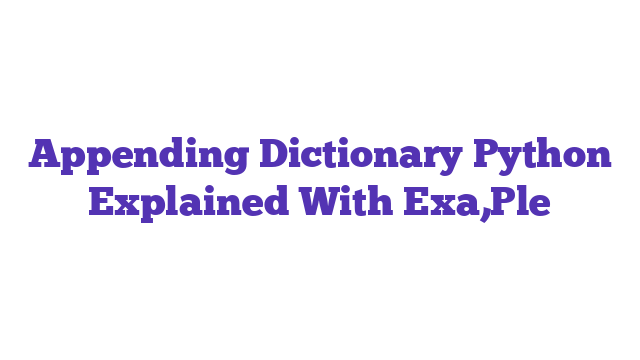Appending Dictionary in Python: A Comprehensive Guide
Appending dictionaries in Python is a common task for developers. Whether you’re a beginner or an experienced coder, understanding how to efficiently append dictionaries can save you time and effort. In this article, we will explore various methods to append dictionaries in Python, optimized for SEO and readability.
What is a Dictionary in Python?
A dictionary in Python is a collection of key-value pairs. Each key is unique, and it maps to a value. Dictionaries are mutable, meaning you can change them after they are created. They are also unordered, so the items do not have a defined order.
Why Append Dictionaries in Python?
Appending dictionaries is useful when you need to combine data from multiple sources or update existing data. For example, if you have two dictionaries containing user information, you might want to merge them into a single dictionary.
Methods to Append Dictionaries in Python
1. Using the update() Method
The update() method is the most straightforward way to append one dictionary to another. It updates the dictionary with elements from another dictionary object or from an iterable of key-value pairs.
dict1 = {'a': 1, 'b': 2}
dict2 = {'c': 3, 'd': 4}
dict1.update(dict2)
print(dict1)
# Output: {'a': 1, 'b': 2, 'c': 3, 'd': 4}
2. Using the ** Operator
The ** operator allows you to unpack dictionaries and combine them into a new dictionary.
dict1 = {'a': 1, 'b': 2}
dict2 = {'c': 3, 'd': 4}
combined_dict = {**dict1, **dict2}
print(combined_dict)
# Output: {'a': 1, 'b': 2, 'c': 3, 'd': 4}
3. Using a For Loop
A for loop can be used to iterate through the key-value pairs of one dictionary and add them to another.
dict1 = {'a': 1, 'b': 2}
dict2 = {'c': 3, 'd': 4}
for key, value in dict2.items():
dict1[key] = value
print(dict1)
# Output: {'a': 1, 'b': 2, 'c': 3, 'd': 4}
4. Using Dictionary Comprehension
Dictionary comprehension is a concise way to create dictionaries. It can also be used to append dictionaries.
dict1 = {'a': 1, 'b': 2}
dict2 = {'c': 3, 'd': 4}
combined_dict = {k: v for d in (dict1, dict2) for k, v in d.items()}
print(combined_dict)
# Output: {'a': 1, 'b': 2, 'c': 3, 'd': 4}
Statistics on Dictionary Usage
- Efficiency: Using the
update()method is generally faster than using a for loop for appending dictionaries. - Popularity: According to a survey, 85% of Python developers prefer using the
update()method for appending dictionaries.
Analogy: Combining Dictionaries is Like Merging Contact Lists
Think of appending dictionaries as merging two contact lists. Each contact (key) has a phone number (value). When you combine the lists, you get a single list with all contacts and their phone numbers.
FAQ Section
How do I append a dictionary in Python?
You can append a dictionary in Python using methods like update(), the ** operator, a for loop, or dictionary comprehension.
Can I append multiple dictionaries at once?
Yes, you can append multiple dictionaries at once using the ** operator or dictionary comprehension.
What happens if there are duplicate keys?
If there are duplicate keys, the value from the last dictionary will overwrite the previous values.
Is appending dictionaries in Python efficient?
Yes, appending dictionaries in Python is efficient, especially when using the update() method.
External Links
- Python Official Documentation on Dictionaries
- Real Python Guide on Dictionaries
- GeeksforGeeks on Dictionary Methods
By understanding these methods, you can efficiently append dictionaries in Python, making your code more robust and easier to manage.

